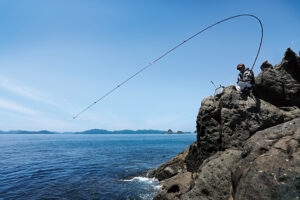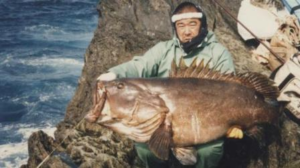Fishing with Tai Rubber
Fishing with Tai Rubber, often called Eye Drop Jig, is one of the very popular lures to catch red seabream or Madai (Pagrus Major.)
In this article, I would like to introduce the tackle, history and a bit of tips to select Tai Rubber.
What is Tai Rubber?
Tai Rubber is a special type of lure, used in offshore fishing, to get red seabreams. It has the line-through round shaped sinker (head), several strips of colored rubber or of silicone (neck-tie), flair of rubber strings (skirt), and one or two hooks. Head size varies from 2 cm to 4 cm in length, and popular weights are ranging from 60 g to 120 g.

The concept is like a combination of a giant Texas sinker and rubber jig.
Basically, this lure is used with retrieving vertically. Once you drop the head to the bottom, which is mostly less than 100m depth, you start to retrieve slowly. Keeping the steady retrieve gives the actions to the head and movements in rubbers, in the current, to attract seabreams.
You can view how it swims in the water from the video below.
History of Tai Rubber
It is said that the style close to modern Tai Rubber is from the Genkai-nada Sea (Nagasaki) or Naruto strait (Tokushima and other areas along the Seto Inland Sea).
Original form of Tai Rubber had no artificial attractors such as rubber, and was used with baits such as shrimp and mantis shrimp. It was not even line-through type, probably because it was easy to produce. However, the shape of the sinker was round as modern one, and it expected to move for a certain pattern in the middle of the current.

By the time of 1920’s, this sinker was combined with artificial materials, and used without any bait.

This picture shows that there was more than one piece of rubber strips, in colors of orange, red, and yellow. There was also a pattern to attach some pieces of seaweed, also.
This combination of round sinker and artificial attractors were not entirely new, at that time. There had been traditional Japanese lures, which had used feathers and dried fish skins.
With this, you could catch Madai, red seabream, without shrimps. Partially because of this economical reason, it spread to many places in Japan. Around that time, the way to fish with this rig was almost the same as current Tai Rubber fishing. In the book, which shows the above images, it explains that fishermen need to pull the line up at a very constant speed, using their hands well (it was done with hand lines). Even when you feel any change in the load of the line, you need to keep the speed. Then it leads to being hooked on their own, without any strike.
This Tai Rubber style had been only for commercial fishermans. The turning point which anglers started to use in their game was in the middle of 2000’s. It was the decade when many former black bass anglers were searching for other kinds of fishing. One reason for it was that there was a negative atmosphere on black bass as an invasive species in Japanese society, and another was that they grew up with black bass boom of the late 1990’s then matured to enjoy or to look for other aspects of angling. After this turning point, Tai Rubber became more sophisticated and diversified, being treated as one type of lures. The currently popular line-through and various applications of materials are such instances of sophistication.
Selection of Tai Rubber
The steps in this fishing are very simple. You only retrieve it up to the surface at a stable speed. Since the action that anglers make onto the lure is monotonous, other aspects make the difference in results. Namely these are choices of lures, in terms of weights, shapes and attractors.
Firstly, you need to select the weight you are sure to know that head is at the bottom. One reference is that 100 g is for 100 m depth. Starting with this, if the water current is stronger, you select a heavier head. In relation to the current, the head weight makes a difference in the angle that the head is being retrieved. When the sinker is lighter, then it is pulled in a slanting angle. It can give you a chance to show the lure for a longer time, at the targeted depth. While the lighter sinker tends to make the line slacked, and this makes sensitivity worse.

Secondly, you select the shape and color of the head.
For the shape, it is important to think how it affects the movement in the water. If the head is bulky, then it tends to have bigger water resistance and is more likely to make bigger turbulence behind the head, which moves rubber neck-ties in bigger motion, or even for the head to make a side-to-side movement. On the contrary, a slim shaped head swims straight.
From the material point of view, lead material heads become more bulky than tungsten material. The tungsten material makes a head more compact, and it is easy or quicker to get to the bottom. The lead has more volume and it may create additional appeal with its size, as written above.
For the color, red and dark colors have low appeal and the chrome has a flashing effect at the depth where the sunlight reaches. To know how colors are reflecting the light in the deep water, you can view this video. https://youtu.be/E4LOgf2DyPg
Thirdly, in combination with head selection, lengths of rubber parts make the difference. The longer it becomes, the more straight it swims in the water. As well as the swirl, which the head makes, the shape of the neck-tie brings a different movement.


The history of Madai fishing made Tai Rubber, in Japan. And now, it is becoming a popular lure for other parts of the world. I hope this article gave you the chance to be reminded that this Tai Rubber has been nurtured by the history of Madai fishing in Japan.


Good morning, sir.
Congratulations on your blog so informative and interesting! Fishing journalist in France, I have written a lot about Tai rubber for 20 years. I love the first 2 photos of the paragraph "history of rubber jig" (drawings). But they are in low definition and I need high definition for an article. I went to the link but I did not find the original illustrations (I consulted the ALL 140 BOOKS of the digital archives - lol - and I also saw the blog of kawagoekk). If you have the links of the original documents to get them in high definition, I thank you in advance. I will mention your name in my article for your help.
Respectfully,
Stéphane Charles
Hi, Stephane.
This is Ty, writer of this article. Thank you for reading my article.
I am looking for the original book, since I cannot find the better resolution photo. Please let me have some more time.
By the way, if you have some topics you want to explore about Japanese style fishing, please tell me. Then I will research for it and write one article.
Thanks.